Dad Man Walking said:
The chain gauges are nice b/c they take the guesswork out of it, and are arguably more accurate than a rule when you factor user error into the equation.
The chain guages (Rohloff and Park) are wildly inaccurate. But at least they
always err on the conservative side (i.e. false/early "replace" indication).
In my experience, they'll indicate your chain is ready for replacment when in reality they are only half way there.
The main error comes from
what they measure: they push opposing rollers in opposite directions, meaning not only chain pitch is measured, but the gap between chain bushing and roller as well (imagine a loose fitting wedding ring).
There is no accepted standard as to what this gap should be, and when you are attempting to measure
half a millimeter of "stretch" across 7 links, that small amount of play inside the roller suddenly is of major significance.
And the few number of links the Rohloff and Park tools measure across is a factor, too. Those gauges are looking for ~0.5mm of "stretch" to indicate .5% wear, while with a 12" ruler is looking for a less error prone ~1.5mm (or ~1/16").
Just as an aside, you would need a full 37.5" of chain for each 0.5% stretch to equal an easy to measure 5.0mm.





